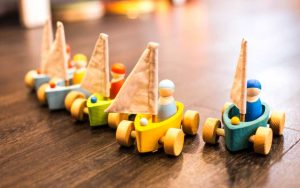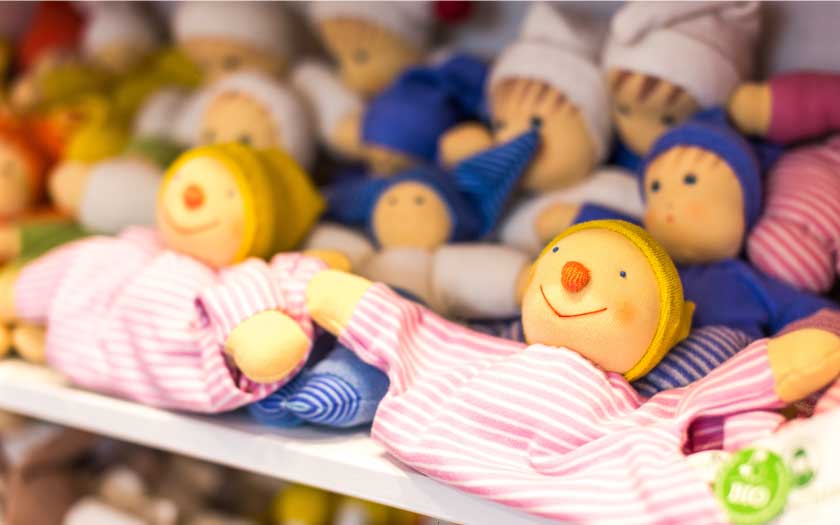When we talk about toys, we automatically think of fun times with lots of laughter and happiness. We think of little children (and big ones too!) playing and exploring their playthings with interest. After all, these are what toys represent – fun times!
Now, while no parent in the world would knowingly expose their children to any danger, they might be doing so inadvertently… through toxic toys! While many parents assume that most toys are safe simply because toy manufacturers say they are, the fact is, conventional toys are often made from materials that pose health risks to growing children.
Dangerous plastic playthings
Have you noticed that the majority of toys in the market are made of plastic? Plastic (PVC) toys commonly labeled non-toxic usually emit substances called poisonous dioxins. Furthermore, the PVC toys are usually softened during the manufacturing process by phthalates which interfere with hormonal functions, growth, and development. Some toy marketers argue that the levels of these chemicals are too low to affect your baby. However, you need to remember that your baby is likely to play with that toy for a long period of time. The cumulative effect of this over time is the real risk associated with toys that are not organic.
Which brings us to the topic at hand, which is, types of toys for yes, today, toys do come in two main categories, which are organic and inorganic. Needless to say, organic toys are toys that are made from natural ingredients and material and contain no toxins, therefore do not harm the health and well-being of your baby as he or she grows and plays.
There are countless reasons and options for choosing natural organic toys for babies and toddlers. Not only are these toys safer in general and do not pose any health risks, but many natural organic toys are designed as educational toys which can be vital for healthy and progressive growth in babies and young children too.
Made from Harmless Materials
For a toy to be certified organic, it cannot contain any kind of dangerous material or harmful substance whatsoever. Highest care and precautions are taken to ensure that no part of that toy emits any toxic fumes or for that matter, is unsafe for a baby’s health, even when gnawed and chewed at!
Organic toys may be made from natural wood, natural rubber, or organic fabric.
Check out Sophie The Giraffe and also Simple Dimple’s rage of organic toys for examples of safe, non-toxic toys for babies and children.
Non-Allergenic
Some babies have hypersensitive skins and many non-organic baby toys contain allergens that can cause nasty, even life-threatening reactions when they come to contact with your baby’s skin. Baby’s skin is thinner and has larger pores and this makes it susceptible even to allergens not expected to react with the skin.
Now, countless parents do not even consider the fact that a baby’s toys can be the culprits for allergic flare-ups and hence take every other precaution imaginable except replacing the little one’s toys with organic ones! Organic toys for babies are made from naturally occurring materials such as solid wood, cotton wool, and other organic materials that are gentle and safe for a baby’s tender skin.

The conventional toy business is not small. There are billions of toys produced (and disposed of!) annually. These toys are major contributors to environmental degradation and pollution. Polyvinyl chloride toys emit dioxins and phthalates which are emitted to the atmosphere where else metallic toys release poisonous lead into the atmosphere too. That aside, most inorganic toys are non-biodegradable meaning that they cannot be broken down by the natural biological processes. This means that once you have no use for them or when they get broken, their ultimate destination will be at a landfill.
Landfills are large, toxic, man-made spots all over the planet where we dump all our wastes and rubbish. Landfills present a major ecological problem, which is why using organic toys is one way to NOT contribute to this environmental degradation!
Are organic toys not ‘educational’ enough?
That is indeed a common misconception about organic toys, probably owing to the general simplicity of their make and designs. Ironically though, it’s this very simplicity that encourages babies to use their ingenuity and artisanship to engage in creative play! Organic toys are generally toys that you have to play with and not toys that do most of the playing for you!
Even though some organic toys for toddlers and babies are not as flashy as the un-natural toys, the natural baby toys are nevertheless beautiful and will be more appealing to your little one’s sense of touch.
What you should know about wooden toys
Toys made from solid wood are decidedly preferable to those made from pressed woods. Pressed wood includes plywood and particleboard, which are formed with glues that give off toxins including formaldehyde, a known carcinogen. You can often see layers of pressed wood if you look at the edges of toys and puzzle pieces. Solid wood doesn’t require the use of toxic chemicals that pressed woods and PVC does.
Solid wood also doesn’t use petroleum—a non-renewable resource—the way that plastics do. Wooden toys made with non-toxic paints and finishes also use and release fewer toxins. Beeswax and natural oil finishes are used instead. Since certified sustainable wood is rare right now, consider solid wood toys that are either unfinished or those that are finished with non-toxic substances. You can also look for toys made from recycled wood.
Safe and lasting
Healthy toys decrease a child’s overall exposure to pollutants, create more demand for sustainable products, and reduce the environmental damage caused by pesticides, plastics, and toxic chemicals. What’s more, when the natural alternatives happen to be both beautiful and fun, they’re less likely to be tossed aside. Here are toys that can endure in your family from one generation to the next—instead of winding up in the local landfill.


